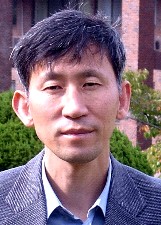Org. Synth. 2008, 85, 131
DOI: 10.15227/orgsyn.085.0131
COPPER-CATALYZED THREE-COMPONENT REACTION OF 1-ALKYNES, SULFONYL AZIDES, AND WATER: N-(4-ACETAMIDOPHENYLSULFONYL)-2-PHENYLACETAMIDE
Submitted by Seung Hwan Cho, Seung Jun Hwang, and Sukbok Chang
1.
Checked by Melissa J. Leyva and Jonathan A. Ellman
2.
1. Procedure
A single-necked, 250-mL round-bottomed flask equipped with a magnetic stir bar was charged with copper(I) cyanide (45.0 mg, 0.5 mmol) (Note 1) and 4-acetamidobenzenesulfonyl azide (12.01 g, 50.0 mmol) (Note 2). Distilled water (100 mL) was added to the flask, and then phenylacetylene (6.04 mL, 55.0 mmol) (Note 3) was added via syringe at room temperature. To this stirred mixture, triethylamine (7.67 mL, 55.0 mmol) (Note 4) was slowly added via syringe over one min at room temperature (Note 5). The reaction mixture was then vigorously stirred while open to air for 4 h at room temperature (Note 6). The reaction was quenched by the addition of a saturated aqueous ammonium chloride solution (20 mL) via syringe at room temperature. Methanol (50 mL) (Note 7) was added, and then the mixture was stirred for an additional 20 min at the same temperature. The resulting mixture was filtered through a Celite pad (7.0 g) (Note 8), and the pad was washed with methanol (5 × 50 mL). The filtrate was concentrated to half volume using a rotary evaporator (20 mmHg, water bath temperature 28 °C), and then the remaining solution was treated with 1N HCl (50 mL) at room temperature to make it slightly acidic (Note 9). The solution was concentrated using a rotary evaporator (20 mmHg, water bath temperature 28 °C) (Note 10), and then the resulting solid was collected by suction filtration with the aid of distilled water (Note 11). The solid was washed with a pre-cooled (0 °C) mixture of diethyl ether and isopropyl alcohol (20:1, 50 mL) followed by diethyl ether (50 mL) (Note 12). The remaining solid was transferred to a pre-weighed 250-mL round-bottomed flask (Note 13) and then was dried under vacuum at room temperature for 12 h to yield a light yellowish solid (14.4 g, 86%) (Note 14). To obtain analytically pure product, the crude material was dissolved in about 800 mL of boiling methanol in a 2-L Erlenmeyer flask (Note 15). The flask was cooled to room temperature and let stand for 30 h. Upon storage in a − 4 °C refrigerator for 3 days, the crystalline product was collected by suction filtration and was washed with 30 mL of pre-cooled (0 °C) methanol (Note 16). The solid was transferred to a pre-weighed 250-mL round-bottomed flask and then was dried under vacuum at room temperature for 10 h to afford N-(4-acetamidophenylsulfonyl)-2-phenylacetamide as a white solid (9.91 g, 60%) (Notes 17, 18).
2. Notes
1.
Copper(I) cyanide (99.98%) was purchased from Aldrich Chemical Co., Inc and was used as received.
2.
4-Acetamidobenzenesulfonylazide (97%) was purchased from Aldrich Chemical Co., Inc and was used as received.
3.
Phenylacetylene (98%) was purchased from Aldrich Chemical Co., Inc and was used as received.
4.
The submitters purchased
triethylamine (99%) from Junsei. Chemical Co., Ltd., and the reagent was distilled from sodium before use. The checkers purchased
triethylamine (99%) from Fisher Scientific Inc., and the reagent was distilled from calcium hydride before use.
5.
During the addition of triethylamine, the original heterogeneous reaction mixture turned to a yellowish solution.
6.
The internal temperature of the reaction mixture increases to 36 °C over 2 h, and the color becomes dark red. The progress of the reaction was monitored by TLC until complete conversion was observed, and during this time the internal temperature returned to room temperature. For TLC analysis, EMD Chemicals, Inc. silica gel 60 F
254 TLC plates were used. 4-Acetamidobenzenesulfonyl azide and
N-(4-acetamidophenyl sulfonyl)-2-phenylacetamide have R
f values of 0.52 and 0.25, respectively (dichloromethane/methanol, 15:1).
7.
The submitters purchased
methanol (99.9%) from Merck & Co., Inc., and it was used as received. The checkers purchased
methanol (HPLC Grade) from Fisher Scientific Inc. and it was used as received.
8.
Celite 545® was purchased by the submitters from Daejung Co., Ltd., and by the checkers from Fisher Scientific Inc., and the reagent was used as received. A glass filter (60 mL) with a medium porosity fritted disc was used. A
round-bottomed flask (1 L) was used to collect the filtrate.
9.
When the 1 N HCl solution was poured into the mixture, a slight exotherm was observed (internal temperature: 29.3 °C) and a white slurry formed. The solution was measured to have a pH of 3.
10.
As the solution was concentrated, solid began to precipitate in the bottom of the
round-bottomed flask.
11.
A 60-mL glass filter with a medium porosity fritted disc was used. Solid that adhered to the flask was transferred using distilled water (two 35-mL portions).
12.
The submitters report 2% of product was lost during this process of filtration and washing, which was measured using an internal standard (1,1,2,2,-tetrachloroethane).
13.
A
round-bottomed flask of joint size 24/40 was used to minimize the loss of product during the transfer.
14.
The submitters report a yield of 12.0–12.3 g, 72.2–74.0% without further purification. However, the elemental analysis that was reported was 0.85% low on carbon; Anal. Calcd. for C
16H
16N
2O
4S: C, 57.82; H, 4.85; S, 9.65; N, 8.43; Found: C, 56.97; H, 4.93; S, 10.10; N, 8.59.
15.
The
Erlenmeyer flask was heated on a hot plate while stirring with a magnetic stir bar and boiling methanol was added until the solid dissolved.
16.
A
porcelain Büchner filter funnel fitted with 90-mm Whatman 1 qualitative filter paper was used.
17.
A half-scale run afforded 5.03 g (61%) of analytically pure product.
18.
The product exhibits the following physicochemical properties: R
f = 0.25 (6.25% methanol in dichloromethane); mp 225-226 °C (decomp);
1H NMR
pdf (400 MHz, DMSO-
d6) δ: 2.09 (s, 3 H), 3.53 (s, 2 H), 7.14-7.15 (d,
J = 7.2 Hz, 2 H), 7.22-7.29 (m, 3 H), 7.76-7.84 (m, 4 H), 10.40 (s, 1 H), 12.26 (s, 1 H);
13C NMR
pdf (100 MHz, DMSO-
d6) δ: 24.2, 42.0, 118.4, 126.9, 128.4, 129.0, 129.3, 132.5, 134.0, 143.9, 169.2, 169.4; IR (neat): 3371, 3241, 3175, 3132, 2970, 1738, 1653, 1590, 1455, 1366, 1167 cm
−1. Elemental analysis; Calcd. for C
16H
16N
2O
4S: C, 57.82; H, 4.85; S, 9.65; N, 8.43; Found: C, 57.77; H, 4.75; S, 9.62; N, 8.43.
Handling and Disposal of Hazardous Chemicals
The procedures in this article are intended for use only by persons with prior training in experimental organic chemistry. All hazardous materials should be handled using the standard procedures for work with chemicals described in references such as "Prudent Practices in the Laboratory" (The National Academies Press, Washington, D.C., 2011 www.nap.edu). All chemical waste should be disposed of in accordance with local regulations. For general guidelines for the management of chemical waste, see Chapter 8 of Prudent Practices.
These procedures must be conducted at one's own risk. Organic Syntheses, Inc., its Editors, and its Board of Directors do not warrant or guarantee the safety of individuals using these procedures and hereby disclaim any liability for any injuries or damages claimed to have resulted from or related in any way to the procedures herein.
3. Discussion
The amide group is a key motif in chemistry and biology.
3 Although traditional chemical methods for amide synthesis rely heavily on an interconversion strategy between carbonyl groups or their equivalent reactive compounds,
4 the lability of those functional groups often restricts their ubiquitous applications. Hence, the development of alternative routes has been challenging to synthetic chemists.
5Recently, we have reported the highly efficient Cu-catalyzed three-component reactions of terminal alkynes, sulfonyl azides, and amines or alcohols to afford amidines or imidates.
6 It is believed that the reaction proceeds via a common ketenimine intermediate, which is generated from the copper-mediated intermolecular cycloaddition of azides and alkynes followed by the release of N
2.
7 On the basis of this postulate, a novel non-conventional amide synthesis could be realized by allowing the plausible ketenimine intermediates, generated in situ under the reaction conditions, to react with water.
8This present procedure describes a convenient approach for the preparation of N-sulfonylamides from the reaction of terminal alkynes, sulfonyl azides, and water in the presence of a Cu(I) catalyst. It should be mentioned that water is employed in this case as both a solvent and reagent. The reaction proceeds smoothly at room temperature within a few hours and generates molecular nitrogen as a sole byproduct. A broad range of both terminal alkynes and sulfonyl azides are readily employed under the reaction conditions as demonstrated in Table 1. In addition, a range of copper(I) reagents can be readily used as the catalyst with a similar efficiency. For example, product yields were not significantly changed upon using either CuI or CuCN catalyst, although the latter displayed a slightly faster reaction rate.
Table 1. Preparation of Various N-Sulfonylamides.a
Appendix
Chemical Abstracts Nomenclature (Collective Index Number);
(Registry Number)
Copper Cyanide; (544-92-3)
Phenylacetylene; (536-74-3)
4-Acetamidobenzenesulfonyl azide; (2158-14-7)
Triethylamine; (121-44-8)
 |
Sukbok Chang received his B.S. degree in chemistry from Korea University in 1985, and M.S. degree from KAIST under the guidance of Professor Sunggak Kim in 1987. In 1996, he earned his Ph.D. degree in organic chemistry at Harvard University working with Professor Eric N. Jacobsen. After postdoctoral experience with Professor Robert H. Grubbs at Caltech, he joined the faculty at Ewha Womans University in Seoul in 1998, and then moved to KAIST in 2002, where he is focusing on the development, understanding, and synthetic applications of transition metal catalysis. |
 |
Seung Hwan Cho was born in Gwang-Ju, Republic of Korea, in 1983. He received his B.S. degree in chemistry from Korea Advanced Institute of Science of Technology (KAIST) in 2005. He is currently in a M.S.-Ph.D. joint program at KAIST under the guidance of Professor Sukbok Chang. His graduate research has focused on development of new organometallic chemistry and studies on the biological activities of new types of heterocyclic compounds. |
 |
Seung Jun Hwang was born in Seoul, Republic of Korea, in 1984. He graduated from KAIST with a B.S. degree in chemistry in 2007. He is currently in a master course in the group of Professor Sukbok Chang at KAIST. He is interested in finding new methodologies using organometallic chemistry for synthetic applications. |
 |
Melissa J. Leyva was born in El Paso, Texas in 1982. She received her B.S. degree in Chemistry at the University of Texas, El Paso in 2005. She then began her doctoral studies at the University of California, Berkeley under the direction of Professor Jonathan A. Ellman. Her graduate research has focused on the identification of novel inhibitors for therapeutically important proteases. |
Copyright © 1921-, Organic Syntheses, Inc. All Rights Reserved